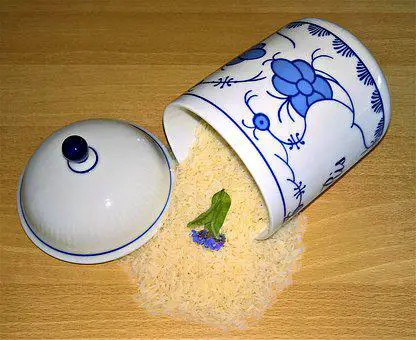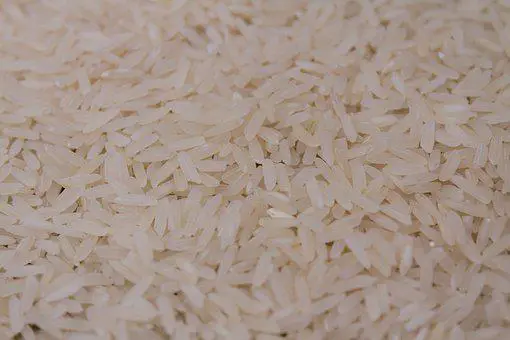If you’re on a low-FODMAP diet, you may be wondering if jasmine rice is a safe food to eat. Let’s take a closer look at the ingredients and find out!
Is Jasmine Rice Low FODMAP?
The answer is a bit complicated. Jasmine rice is made from white rice, which is low in FODMAPs. However, the manufacturing process of jasmine rice can add additional ingredients that may be high in FODMAPs.
For example, some brands of jasmine rice may be coated with a starch that is high in FODMAPs. This is done to improve the texture and shelf life of the rice.
What is Jasmine Rice?
Jasmine rice is a type of white rice that is popular in Asian cuisine. It is often used in Thai and Vietnamese dishes. Jasmine rice has a slightly sweet flavor and a delicate, floral aroma similar to soup.

How To Prepare Jasmine Rice With FODMAP?
If you’re on a low-FODMAP diet, it’s important to choose a brand of jasmine rice that is labeled “gluten-free” and “FODMAP friendly.” Be sure to check the ingredients list to make sure there are no high-FODMAP additives.
When cooking jasmine rice, be sure to rinse it thoroughly before cooking. This will help remove any potential FODMAPs that may be on the surface of the rice.
Ingredients
- White rice
- Starch
- Gluten-free
- FODMAP friendly
Instructions
- Rinse the jasmine rice thoroughly before cooking.
- Add the rice to a pot of boiling water in a ratio of one part rice to two parts water.
- Bring the water to a boil, then reduce the heat and simmer for 18 minutes.
- Remove the pot from the heat and let it sit for five minutes before fluffing the rice with a fork. Serve immediately.
Assuming you can find a FODMAP-friendly brand of jasmine rice, this grain is a great addition to your low-FODMAP diet! It’s versatile, delicious, and easy to prepare. You can eat it for dinner. Give it a try the next time you’re looking for a quick and easy side dish!
9 Benefits Of Jasmine Rice Low FODMAP
There are nine benefits of Jasmine rice with low FODMAP.
Some of the benefits include:
1. Good Source Of Energy
Jasmine rice is a good source of energy. It is rich in carbohydrates which is necessary for the body to produce ATP (adenosine triphosphate).
ATP is responsible for providing the energy needed by the cells to perform their functions.
2. Good Source Of Thiamin, Niacin, And Vitamin B
These vitamins are important for the nervous system’s function.
- They also help in the production of red blood cells and energy metabolism.
- Thiamin is also known as vitamin B-. It is water-soluble and is not stored in the body.
- Niacin is also known as vitamin B-. It is water-soluble and is not stored in the body.
- Vitamin B- is a water-soluble vitamin and is not stored in the body.
3. Low In Fat And Cholesterol
Jasmine rice is low in fat and cholesterol. This makes it a good choice for those who are trying to lose weight or maintain a healthy weight.
It is also a good option for people with heart conditions because it helps to lower LDL (bad) cholesterol levels and raise HDL (good) cholesterol levels.
4. Gluten Free
Jasmine rice is gluten-free. This makes it a good choice for people with celiac disease or gluten intolerance. It is also a good option for people who are trying to avoid gluten for other reasons.
5. Easy To Digest
Jasmine rice is easy to digest. This is due to the fact that it is a simple carbohydrate.
Simple carbohydrates are broken down by the body more easily than complex carbohydrates.
6. Not Addictive
Jasmine rice is not addictive. This is because it does not contain gluten.
Gluten is a protein that is found in wheat, rye, and barley. It is responsible for the elastic texture of dough. It is also responsible for the “chewy” texture of some foods.
7. Good For People With Celiac Disease
Celiac disease is an autoimmune disorder that is caused by the ingestion of gluten.
Symptoms of celiac disease include abdominal pain, bloating, diarrhea, and weight loss. People with celiac disease must avoid gluten in order to prevent these symptoms.
8. Aids In Weight Loss
This helps in aiding weight loss by reducing the number of calories you eat. It also helps in the reduction of the fat cells in the body. It also helps to regulate blood sugar
9. Reduces The Risk Of Heart Disease
Jasmine rice also helps in reducing the risk of heart disease. This is because it is low in cholesterol and fat. It also helps to reduce the LDL (bad) cholesterol levels in the body and increase the HDL (good) cholesterol levels.
What Is The Nutrition Information For Jasmine Rice With Low FODMAP?
The nutrition information for jasmine rice with low FODMAP is as follows:
- Serving size: ½ cup (120 ml)
- Servings per recipe: 12
- Calories: 160
- Fat: 0.36 g
- Saturated fat: 0.05 g
- Polyunsaturated fat: 0.02 g
- Monounsaturated fat: 0.02 g
- Cholesterol: 0 mg
- Sodium: 11 mg
- Potassium: 47 mg
- Carbohydrate: 35.34 g
- Dietary fiber: 0.40 g
- Sugars: 0.03 g
- Protein: 33.33 g
- Vitamin A: 0 IU
- B12 Vitamin
- Vitamin C: 0 mg
- Calcium: 11 mg
- Iron: 0.27 mg

Where Is Jasmine Rice With Low FODMAP Found?
Jasmine rice is found in most Asian markets. It is also available in some health food stores and online and is often labeled as “glutinous” or “sticky” rice.
How Do I Know If Jasmine Rice Is Fresh?
The best way to tell if jasmine rice is fresh is to smell it. Rice that is more than a few months old will have a musty or sour smell. You can also look for signs of mold or insects. If the rice is infested, it should be discarded.
When Is Jasmine Rice With Low FODMAP Harvested?
Jasmine rice is typically harvested in the fall. However, it is available year-round in most stores.
How Do I Store Jasmine Rice?
Jasmine rice should be stored in a cool, dry place. It can be stored in the pantry, cupboard, or fridge and is best stored in an airtight container just like figs.
Conclusion
The conclusion of this blog is that Jasmine rice is a healthy, nutritious, and delicious option for those on a Low FODMAP diet. It is easy to digest, gluten-free, and aids in weight loss. It is also a good choice for people with celiac disease or gluten intolerance and is found in most Asian markets. Jasmine rice is best stored in a cool, dry place and is typically harvested in the fall.
7
Leave a Reply